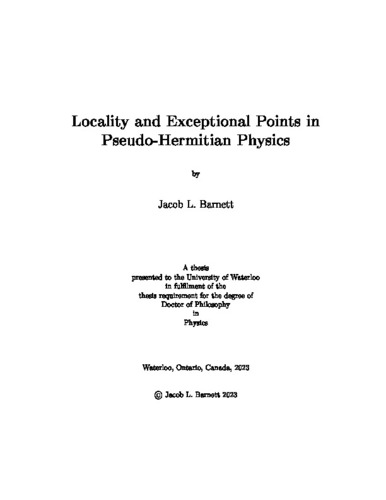| dc.contributor.author | Barnett, Jacob | |
| dc.date.accessioned | 2023-05-26 13:23:43 (GMT) | |
| dc.date.available | 2023-05-26 13:23:43 (GMT) | |
| dc.date.issued | 2023-05-26 | |
| dc.date.submitted | 2023-04-19 | |
| dc.identifier.uri | http://hdl.handle.net/10012/19490 | |
| dc.description.abstract | Pseudo-Hermitian operators generalize the concept of Hermiticity. Included in this class of operators are the quasi-Hermitian operators, which define a generalization of quantum theory with real-valued measurement outcomes and unitary time evolution. This thesis is devoted to the study of locality in quasi-Hermitian theory, the symmetries and conserved quantities associated with non-Hermitian operators, and the perturbative features of pseudo-Hermitian matrices.
An implicit assumption of the tensor product model of locality is that the inner product factorizes with the tensor product. Quasi-Hermitian quantum theory generalizes the tensor product model by modifying the Born rule via a metric operator with nontrivial Schmidt rank. Local observable algebras and expectation values are examined in chapter 5. Observable algebras of two one-dimensional fermionic quasi-Hermitian chains are explicitly constructed. Notably, there can be spatial subsystems with no nontrivial observables. Despite devising a new framework for local quantum theory, I show that expectation values of local quasi-Hermitian observables can be equivalently computed as expectation values of Hermitian observables. Thus, quasi-Hermitian theories do not increase the values of nonlocal games set by Hermitian theories. Furthermore, Bell's inequality violations in quasi-Hermitian theories never exceed the Tsirelson bound of Hermitian quantum theory.
A perturbative feature present in pseudo-Hermitian curves which has no Hermitian counterpart is the exceptional point, a branch point in the set of eigenvalues. An original finding presented in section 2.6.3 is a correspondence between cusp singularities of algebraic curves and higher-order exceptional points. Eigensystems of one-dimensional lattice models admit closed-form expressions that can be used to explore the new features of non-Hermitian physics. One-dimensional lattice models with a pair of non Hermitian defect potentials with balanced gain and loss, Δ±iγ, are investigated in chapter 3. Conserved quantities and positive-definite metric operators are examined. When the defects are nearest neighbour, the entire spectrum simultaneously becomes complex when γ increases beyond a second-order exceptional point. When the defects are at the edges of the chain and the hopping amplitudes are 2-periodic, as in the Su-Schrieffer-Heeger chain, the PT-phase transition is dictated by the topological phase
of the system. In the thermodynamic limit, PT-symmetry spontaneously breaks in the topologically non-trivial phase due to the presence of edge states.
Chiral symmetry and representation theory are utilized in chapter 4 to derive large classes of pseudo-Hermitian operators with closed-form intertwining operators. These intertwining operators include positive-definite metric operators in the quasi-Hermitian case. The PT-phase transition is explicitly determined in a special case. | en |
| dc.language.iso | en | en |
| dc.publisher | University of Waterloo | en |
| dc.subject | Quantum Theory | en |
| dc.subject | Pseudo-Hermitian | en |
| dc.subject | Quasi-Hermitian | en |
| dc.subject | Exceptional Points | en |
| dc.subject | C*-Algebras | en |
| dc.subject | Lattice Models | en |
| dc.subject | PT-Symmetry | en |
| dc.subject | Nonlocal Games | en |
| dc.subject | Balanced Gain and Loss | en |
| dc.subject | Indefinite Inner Product Spaces | en |
| dc.subject | Non self-adjoint Hamiltonians | en |
| dc.subject | Free fermions | en |
| dc.title | Locality and Exceptional Points in Pseudo-Hermitian Physics | en |
| dc.type | Doctoral Thesis | en |
| dc.pending | false | |
| uws-etd.degree.department | Physics and Astronomy | en |
| uws-etd.degree.discipline | Physics | en |
| uws-etd.degree.grantor | University of Waterloo | en |
| uws-etd.degree | Doctor of Philosophy | en |
| uws-etd.embargo.terms | 0 | en |
| uws.contributor.advisor | Forrest, James | |
| uws.contributor.advisor | Joglekar, Yogesh | |
| uws.contributor.affiliation1 | Faculty of Science | en |
| uws.published.city | Waterloo | en |
| uws.published.country | Canada | en |
| uws.published.province | Ontario | en |
| uws.typeOfResource | Text | en |
| uws.peerReviewStatus | Unreviewed | en |
| uws.scholarLevel | Graduate | en |

